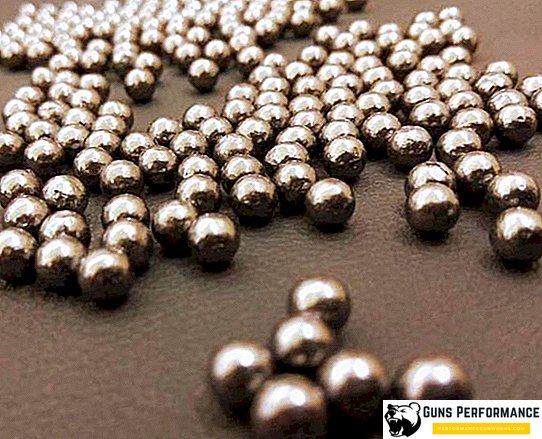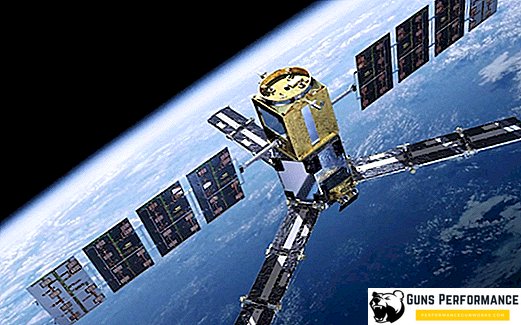The development of the submarine fleet in the USSR after the end of the Second World War moved in two directions. The beginning of the nuclear era gave impetus to the development of a whole class of new warships - submarines with a nuclear power plant. New submarines received qualitatively new tactical and technical characteristics, which immediately significantly increased the combat capabilities of the fleets. It seemed to everyone that the time of the submarines with the usual propulsion system was hopelessly gone. The submarine fleet had to follow the path of increasing the firepower of the ships and increasing the autonomy period of navigation. However, time has shown that a submarine with a diesel-electric power plant is still a formidable weapon, which continues to form the basis of many military fleets.

Project 677 was a real confirmation of the importance of the place of diesel boats in the combat readiness system of the modern fleet.
The role played by diesel-electric submarines in the Russian Navy
Despite the constant excellence of nuclear power plants, diesel submarines have not lost their relevance to this day. On the contrary, in recent years there has been a tendency to increase the number of warships of the submarine class in many foreign fleets. Almost all the fleets of leading maritime powers, including the US Navy, the United Kingdom, France, Japan and the Chinese Navy, continue to replenish with diesel-electric submarines.
The Russian navy, which in addition to nuclear submarines is armed with combat ships with a conventional power plant, was no exception. Back in the late 80s, when the Soviet Union managed to achieve parity with the United States at sea in the nuclear component of strategic armaments, Soviet shipyards continued to launch submarines with a conventional power plant.
While nuclear submarines and multi-purpose submarines carried out strategic tasks in the ocean, diesel-electric submarines continued to carry out the main combat load in the coastal marine zone. The defense of the maritime frontiers of Russia in the waters of the Baltic and Black Sea, the defense of the northern flank of the maritime theater is the main task that military ships of the Russian Navy with conventional power installations are performing today. The backbone of the submarine forces of the Black Sea and Northern Fleet of Russia is diesel submarines of the type "Varshavyanka" and submarine project 677 of the type "Lada".

The presence of submarines in the maritime theater has always made significant limitations to the tactical plans of the naval command of the opposing sides. The threat that comes from the depths casts doubt on the combat power of any warship. Submarines became an important deterrent to the aggressive actions of the fleets of the opposing sides. So it was during the First World War. So it was during the Second World War - the heyday of submarines, as a class of warships.
Today, in the era of the domination of advanced technology, diesel submarines have become an even more formidable force. The firepower of diesel-powered submarines, which increased many times, the appearance of rocket weapons and advanced sonar characteristics, made the diesel-electric submarines multi-purpose and universal ships. Using the example of Soviet ships of the Varshavyanka and Lada type, we can talk about the full implementation of the concept of middle-class submarines. Thanks to the increased autonomy of navigation and secrecy, modern submarines of the Russian Navy are able to perform the following combat missions:
- to conduct marine exploration in the waters of the internal seas and in the economic maritime zone;
- to carry out the defense of ports, naval bases and coastal maritime communications;
- carry out strike operations to neutralize the naval formations of the fleet of a potential enemy;
- disrupt trade and transport sea communications of a potential enemy;
- conduct anti-sabotage and sabotage activities.
The small size allows submarines with a conventional power plant to control the shallow water, to penetrate into the closed coastal areas. The functional, operational and combat capabilities of project 677 submarines increased. The ships received powerful armaments and advanced radar equipment.
The history of the submarine project 677 "Lada"
The first research work on the creation of a large diesel-electric submarine began in 1987. It was planned to carry out the construction of ships in large series. To this end, the project submarine 677 type "Lada" was customized to the production capacity of several shipyards in the country. In total, four shipyards were to be involved in replenishing the fleet and for building the export version of the vessel: the Admiralty Shipyards in St. Petersburg, the Sevmash, the Nizhny Novgorod enterprise Krasnoye Sormovo and the Leninsky Komsomol plant in Komsomolsk-on-Amur.
The first version of the project was sent for revision. The final draft 677 was approved in 1997 and sent to shipbuilding plants.

The first submarine "St. Petersburg" project 677 was laid on the Leningrad JSC "Admiralty Shipyard" in December 1997. Almost 7 years lasted for the construction of the submarine. At first unfinished due to insufficient financing of the order. Further, a hindrance to the introduction of the submarine was the introduction of changes to the current project. These and many other factors led to the fact that the construction of the boat either stopped or resumed again.
Despite the existing difficulties, the ship was still launched in 2004, receiving the tail number B-585 and the resounding name "St. Petersburg". However, the difficulties with putting the ship into service did not end there. Timely delivery of the object interfered with the frequent change of the commanders of the Russian Navy. At the highest command level there were even opinions that the Russian fleet did not need such vessels at all. The new ship had a number of critical flaws in the design of the propulsion system. Not gave the proper results and submarine sea trials. Only six years later, in April 2010, the first ship of the project 677 submarine "St. Petersburg" of the type "Lada" entered service of the Northern Fleet of Russia.
Launching of the main units and systems of the combat ship was carried out in a trial operation mode.
The boats of the project 677 were to be produced in large quantities, both for equipping the domestic Navy and for exporting. The main foreign customer for Russian submarines was China. To equip the Black Sea, Baltic and Northern fleets, it was necessary to surrender 20 ships by 2020.
The failures that occurred during the commissioning of the St. Petersburg submarine during the operation led to changes in the project. At the highest command level, it was decided to modernize the project. Launched in 2005-06, the submarine B-586 Kronstadt and the submarine B-587 Velikie Luki will have to be upgraded and re-equipped at the construction stage.
Design features submarines project 677
The new ships belong to the fourth generation of ships, which should, according to their tactical and technical characteristics, be a further development of the export project 877. Unlike the submarines of the project 636.6 Varshavyanka, the new diesel-electric boats have a smaller displacement and size. The new ship was supposed to be cheaper in construction, but to have the same low noise parameters and have equally powerful weapons.

Boats received in the NATO classification code "Kilo" and are considered perhaps the most quiet and secretive ships in modern fleets. Together with their older sisters, submarines of Project 636.6 (according to NATO’s Improved Kilo classification), the Lada-type boats were supposed to provide the strike force of the Russian Navy in the internal waters.
The main criterion for the project was a significant amount of R & D implemented in the project. The task of developers and designers was to pull submarines of the project 636.6 to a higher technological level.
For reference: for the first time on the diesel-electric submarine "St. Petersburg" non-penetrating devices were used in the form of retractable masts, providing the boat with an underwater course at the periscope depth. Innovation was introduced to all subsequent warships such as "Varshavyanka".
In addition, the project creators and shipbuilders managed to create a new ship, which, according to firepower, is the most powerful among the ships of the same type in its class.
Submarine hull and power plant
Submarine "St. Petersburg" has a one-and-a-half hull dial pattern. The robust case has asymmetrical shapes and is made of steel grade AB-2. Over the entire length of the robust case has the same diameter. The bow and stern are part of the light hull and are conical. Project 677 boats have three decks - tiers. The hull is divided by watertight bulkheads into five independent compartments. In the first, nose compartment installed the latest sonar equipment. The command post of the boat is in the second compartment. The following 3 and 4 compartments are residential decks. In the latter, in the fifth aft compartment is the power plant of the ship.

Almost all the moving parts of the hull are equipped with acoustic protection elements that should reduce the noise level of the ship during its operation. Outside the hull of the submarine has a protective multi-layer protective coating, the thickness of which is 40 mm. Due to this innovation are minimized sonar parameters of the movement of the ship under water.
On the cabin of the ship are installed rudders of depth, which increased the ability to control boats on the underwater course. The main control of the submarine is carried out with the help of the tail aft tail, which has a cruciform structure. In the design of the ship, everything from the hull form, protected by a special sonar coating and ending with the steering devices, is aimed at increasing the submarine’s secrecy. The first submarine of the B-585 St. Petersburg series has a displacement of 1,765 tons, which is a third less than the displacement of the Varshavyanka-type project 636.6 ships
The power plant PL "Lada"
A diesel-electric boat is a ship, the movement of which is carried out due to the work of diesel engines and electric generators. Boat 677 of the project has the main propulsion system, consisting of 2 diesel generators 28DG, with a capacity of 1000 hp. each. Electric direct current supplied to the electric motor SED-1, is produced during the operation of diesel engines D-49. The motor has a brushless design and is characterized by a reduced number of revolutions. The power of the electric motor on the propeller shaft is 4100 hp
The propulsion system is controlled remotely from the command post. All the work of the propulsion system has a digital control system. The movement of the submarine is carried out by rotating the seven-blade propeller with a fixed pitch. Remote screw speakers provide an evolution of the ship during mooring operations.
In the process of acceptance tests, some defects in the engine operation were detected, especially at low revs (up to 125 m / s). Modernization of engines on the submarine "St. Petersburg" was carried out in 2007. During the limited operation mode, the propulsion system of the new ship operates at 60% of the design capacity. Submarines have a working stroke in the surface position to 10 knots. At depth, the ship can travel at a speed of 21 knots.
Armament submarines project 677
Diesel-electric boats are traditionally equipped with mine-torpedo weapons. On Lada-type boats, the main armament is torpedo 533 mm vehicles. The ammunition of the ship is 18 torpedoes. Torpedo tubes are designed to use weapons of various modifications, including guided torpedoes and anti-submarine missile-torpedoes.
Like the submarines of Project 636.6, Project 677 ships could carry cruise missiles. Submarine "St. Petersburg" was developed for the installation of PKR "Onyx". The cruise missile, despite its great firepower, seemed like an expensive weapon, so during the modernization process it was decided to replace the Onyx anti-ship missiles with new anti-ship Caliber missiles. To do this, the ships installed the installation of a vertical launch. The next in the series of submarines "Kronstadt" and "Great Luke" should also be equipped with 4 launchers for anti-ship missiles "Caliber".

The air defense system of the ships was Igla-1 MANPADS and anti-aircraft missiles installed in remote containers.
In addition to the strong rocket and torpedo weapons, Project 677 submarines carry powerful and modern sonar weapons. SJC "Lira" has highly sensitive nasal and airborne antennas, due to which complete (3600) hydroacoustic situation on the entire underwater horizon.
The hydroacoustic complex occupies the entire upper deck of the bow of the submarine ship. In addition to fixed equipment on the boat there is a towed antenna. Navigation equipment is represented by an inertial system, with the help of which the safe movement of the ship under water and on the surface with a limited visibility mode.
Project 677 boats today - prospects
Creating new submarines as a variant of the technical development of Amur project ships 636.6 and 877, the designers tried to simultaneously equip the ship with all possible know-how in the field of submarine shipbuilding at that time. The effect was not quite as expected. Many systems of the ship were raw and could not be fully adapted to the requirements of the technical specifications. This primarily affected the propulsion system of the ship and its sonar equipment.

Launched and commissioned the St. Petersburg submarine is currently in limited operation mode. The construction of two other ships is carried out taking into account the results of the operation of the lead ship. Changes to the design and modernization of vessels are carried out in the course of construction.
In all other respects, ships of the project 677 meet the latest requirements for ships of this class. The autonomy of swimming is 45 days. The crew of the submarine, in contrast to the "Warsaw" women, decreased to 35 people. In terms of armament, the element of stealth and range, Russian submarines today have no analogues in foreign fleets. The introduction of the next ships of the series is scheduled for 2018, the beginning of 2019.












